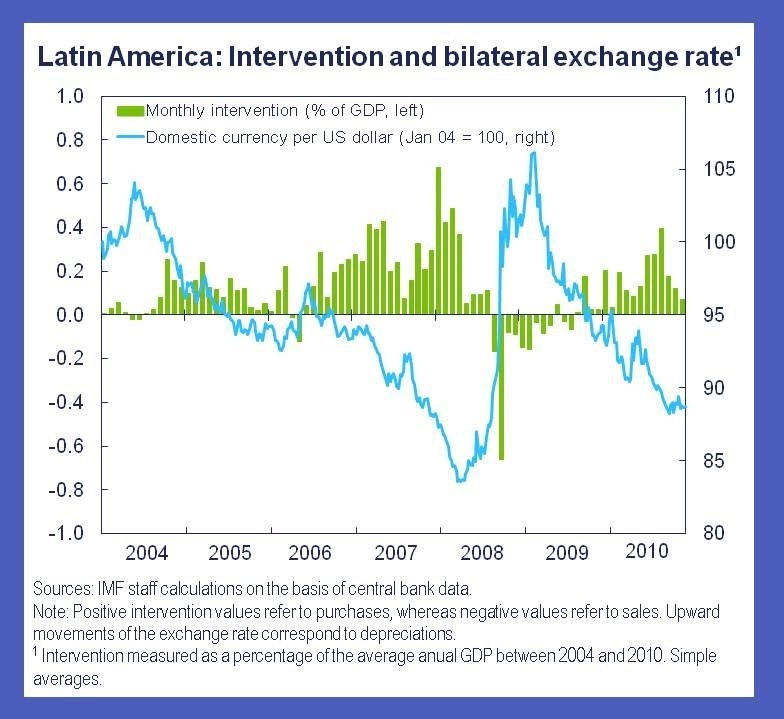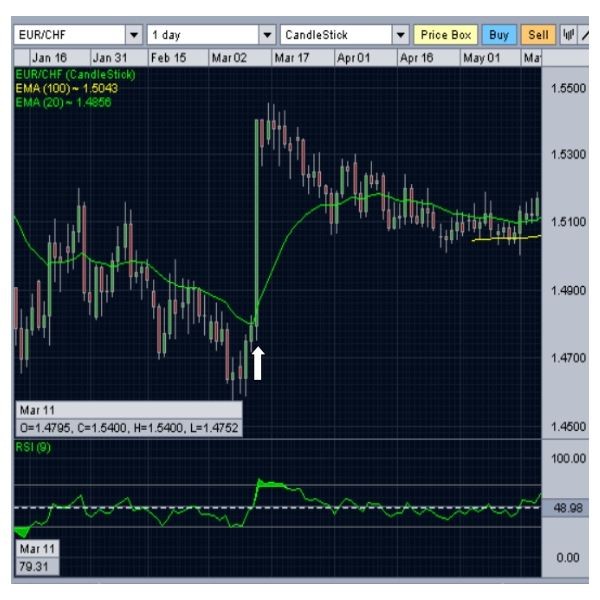Central Bank Intervention – the reasons and its effects on the FX Market
Post on: 29 Июнь, 2015 No Comment

Central Bank Intervention
Important: This page is part of archived content and may be outdated.
A central bank will buy or sell a currency in the foreign exchange market in order to increase or decrease the value its nation’s currency possesses against an alternative currency. This is known as currency intervention, central bank intervention, or more informally as Forex market intervention. When a country’s currency is enduring extreme and unnecessary upward or downward financial pressure, (usually caused by high volatility from a surge of trading by speculators and market players) a government or central bank will use Forex market intervention to stabilise the situation. Central bank intervention can be used to boost or decrease a currencies value, most commonly for the purpose of boosting and decreasing productivity and exports of a nation. There has been much criticism directed at governments who use market intervention excessively to amplify their currency’s value.
The most common reason for central bank intervention over the last decade or so would be because of a sharp or sudden decline in the value of a currency. It can however turn problematic for a nation to use market intervention whenever the currency value does decline steeply in the foreign exchange market and it will lead to several disadvantages to the nation. Export-dependent countries could spiral into recession if they become too reliant on market intervention. Global trading partners’ exchange rates will rise as well, while the prices of their exports increase within the global market place. A decline in value of a nations’ currency can also lead to an increase in inflation as prices of imported services and goods are will go up. Subsequently, interest rates will be augmented by the central bank but will unfortunately disturb the economic growth and asset markets, and possibly developing into a decline of the currency’s value. Nations with large budget deficits rely on foreign inflows of capital. A decline in the value of a currency can cause major financial difficulty to countries with high budget deficits. Financing the deficits will be extremely delayed and will jeopardize the economic growth of a nation. In order to maintain the value of the currency, there will need to be an elevation of interest rates.
It is imperative the central bank takes the correct measures without focussing entirely on the value of its currency; otherwise forex market intervention could potentially hurt the nations’ economy.
The four forms of market intervention
Although there are many forms of foreign exchange intervention, there are four which can be considered the most significant and frequent. They are Intervention, Operational, Concerted and Sterilized intervention. Intervention (‘jawboning’) is known to be less complex and cheaper than any other type of intervention as foreign currency reserves are not disrupted during the process. Representatives of the central bank and the Ministry of Finance negotiate over a currency by ‘talking up’ or ‘down’ about it. Through this, they determine a currency to be over or under valued.
The representatives can also use Operational intervention where concrete buying or selling of the currency takes place. Even though this form of intervention is considered a lot simpler than others, it is not however the most efficient and effective. For instance, it is not suitable for nations whose central banks intervene often; they are more likely to use verbal intervention so as to be more effective.
Concerted intervention can also be verbal so that many representatives from varying countries can unify and discuss apprehensions over a currency that may be continuously fluctuating. Through Concerted intervention, nations unify to escalate or lower specific currencies with the use of their individual foreign currency reserves. The effectiveness and success of this type of intervention relies on the amount of nations involved and the overall amount of intervention (known as the breadth and depth).
Sterilized Intervention involves a central bank using its monetary policy practices; doing so through adjusting its interest rate goals and its open market operations to intervene in the forex market. Another way of describing the event of sterilizing a currency is when a central bank sells market instruments to try and claw back excess funds. There is a possibility of Forex interventions to go unsterilized or perhaps slightly sterilized when performances in the currency market are aligned along with monetary policies as well as foreign exchange policies.
An occasion like this happened in the concerted interventions of the ‘Plaza Accord’. In September 1985, G7 went on to stem the extreme increase of the Dollar by buying the ‘Plaza Accord’s’ currencies and then selling the Dollar. From there on, Japanese deposits were considered better compared to the US. Japan’s short-term interest rates were raised by 200 bps and the 3-month Euro yen underwent a large increase of 8.25 %. Of course, this process turned out well as the monetary policies and foreign exchange policies were adopted.
A further example of this was in February 1987. The G7 collaborated with the ‘Louvre Accord’ in order to prevent the sinking of the Dollar. After this, the Federal Reserve became tightly accustomed to the monetary policies while the rates were increased by 300 pips reaching a peak level of 9.25% in September.
An example of a successful forex market intervention could be when a central bank uses an amount of USD 5 million on intervention and is then able to increase the currency value by around 2% in opposition to other currencies within thirty minutes. A move like this can seem threatening the next time a central bank wants to step in the market. Even the possibility of losing funds off a currency in another trading session does not seem as frightful to a central bank when the central bank is able to achieve a successful intervention in the Forex market. Important aspects of achieving such an intervention depend on timing, momentum, size and sterilization.
Size

The enormity of an intervention coincides with the final move of a currency. The Bank of Japan holds $550 billion of Forex reserves while the European Central Bank holds $330 billion and the Bank of China holds $346 billion. As of 2003, these three central banks obtain the top most quantity of Forex reserves. It is essential that a central bank supplies a generous amount of foreign exchange currency reserves. The size of the currency intervention can determine the affect of the intervention and whether it was successful or not.
Timing
When grabbing a market player off guard with an intervention, it is more probable for them to be suddenly bundled with a huge inflow of orders. However, if the timing is wrong, and market players are expecting intervention, then the huge inflow of orders is better grasped although the effect is rather low.
Momentum
As a currency is moving in the aimed direction of the intervention, it is the most ideal, suitable time to apply intervention. Since the Forex market has a volume of 1.2 trillion Dollars per day, the intervention of 3-5 billion Dollars seems too little; therefore central banks generally prefer to anticipate favourable currents rather than intervening against the market trend. Central banks do this through verbal posturing, which is a sort of indication given to traders of the upcoming intervention.
Sterilization
This is the procedure of when central banks abide by monetary policies alongside Forex market performances. Doing so generates a preferred long-term modification in the currency.
Forex traders are recommended to be cautious while selecting stop losses and while submitting an order during central bank interventions. It is advisable to consider levels of support as it is here where central banks intrude in order to affect a currency’s valuation. It is a golden rule in Forex trading never to trade against market intervention. The volume and power behind a central bank’s intervention is enough to significantly dent your trading account balance. Always try to be aware of the planned central bank intentions for market intervention, and plan your trading accordingly.














